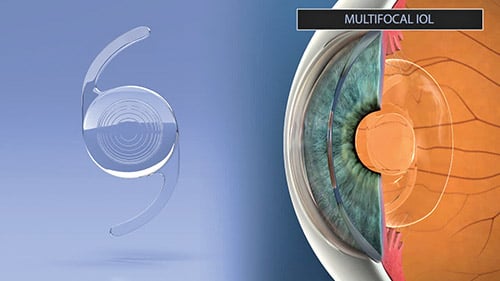

Cataracts are a naturally occurring process in the human eye. In normal development, we are born with a clear lens that focuses images onto the back of the eye (the retina) like a lens focuses images for your camera. Over time, ultraviolet light from the sun, by-products of the foods that we eat, and our environment gradually cause the lens to become cloudier and cloudier. This can begin to impact vision, usually after the age of 40, and become what we know as a cataract.
Just having a cataract does not mean that any treatment is required. Generally, treatment is indicated when the symptoms begin to interfere with your daily activities and enjoyment of life. Common symptoms of cataracts include increasing difficulty seeing to drive at night, disabling glare from oncoming car headlights, and hazy vision in bright sunlight (glare). You may find that reading and TV viewing are more and more of a struggle, even with updated eyeglasses.
The only treatment for cataracts is surgery. This involves using an instrument through a microincision at the side of the eye to remove the cloudy lens material, and replacing it with a tiny prosthetic lens implant, like replacing the faulty lens of a camera. This usually takes less than 10 to 15 minutes, requiring only local anesthesia, and can be done in an ambulatory care setting. This means that you can be home and doing most of your normal activities within a couple of hours of having your surgery performed. One eye is done one day, and the other can usually be done anywhere from two to four weeks later, depending on a patient’s preference and satisfactory recovery.
Most patients are less dependent on eyeglasses after cataract surgery, and many options are available to further enhance the result. For example, surgery can be performed with the assistance of laser (Femtosecond laser with Catalys or LensX technology), which can make faster recovery possible and reduce astigmatism (irregularities in the shape of the cornea, the clear front surface of the eye) for sharper vision. Advanced technology lens implants (ATIOLS) like the Symfony and PanOptix lenses can give patients the freedom to do more activities without the use of eyeglasses after surgery. These special options are not covered by health insurance, so it is good to begin to consider how you feel about eyeglass use before it is time to decide upon cataract surgery, so that you know about your possible choices and invest wisely.
A comprehensive eye exam is the way to know if you have cataracts, so make sure to schedule one at least annually. If your eye doctor says that you have cataracts, don’t panic! Pay attention to your daily functioning, and consider whether your vision is interfering with the things you want and need to do the most. If it is, there are outstanding treatment options available to help you recover your sight, and continue to live your very best life.
Dr. Daniel Stegman, M.D. is a glaucoma specialist with NJ Eye and Ear in Englewood.











